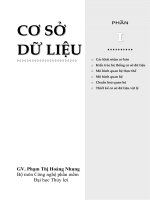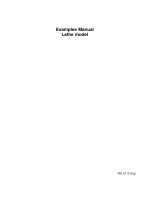C734 01
Bạn đang xem bản rút gọn của tài liệu. Xem và tải ngay bản đầy đủ của tài liệu tại đây (20.63 KB, 2 trang )
Designation: C 734 – 01
Standard Test Method for
Low-Temperature Flexibility of Latex Sealants After Artificial
Weathering1
This standard is issued under the fixed designation C 734; the number immediately following the designation indicates the year of
original adoption or, in the case of revision, the year of last revision. A number in parentheses indicates the year of last reapproval. A
superscript epsilon (e) indicates an editorial change since the last revision or reapproval.
4. Summary of Test Method
4.1 A slab of the sealant is exposed, after drying, for 500 h
in an artificial weathering unit, after which it is conditioned and
flexed at − 17 6 1°C (0 6 2°F).
1. Scope
1.1 This test method covers a laboratory procedure for the
determination of low-temperature flexibility of latex sealants
after 500 h artificial weathering.
1.2 The values stated in metric (SI) units are to be regarded
as the standard. The values given in parentheses are for
information only.
1.3 This standard does not purport to address all of the
safety concerns, if any, associated with its use. It is the
responsibility of the user of this standard to establish appropriate safety and health practices and determine the applicability of regulatory limitations prior to use.
5. Significance and Use
5.1 This test evaluates the flexibility of artificially weathered latex sealants in a low-temperature environment.
6. Apparatus
6.1 T3 Temper Alclad Aluminum Panels, three, each 76 by
153-mm (3 by 6-in.) of 16 to 24 gage (1.29 to 0.511 mm),
conforming with CSA Specification HA-4 CC42.
6.2 Accelerated Weathering Unit—One of the units either of
the Type D through F as described in Practice G 23 or Type A
through BH as described in Practice G 26, plus a 102-18
cycling cam and black panel accessories.
6.3 Cold Box or Freezer.
6.4 Mandrel, Wood or Metal, 25 mm (1 in.) in diameter.
6.5 Template, consisting of a 3.2-mm (1⁄8-in.) thick brass
plate with a rectangular opening 38 by 127 mm (11⁄2 by 5 in.).
6.6 Spatula, metal.
NOTE 1—Currently there is no ISO standard similar to this test method.
2. Referenced Documents
2.1 ASTM Standards:
C 717 Terminology Building Seals and Sealants2
G 23 Practice for Operating Light-Exposure Apparatus
(Carbon-Arc Type) With and Without Water for Exposure
of Nonmetallic Materials3
G 26 Practice for Operating Light-Exposure Apparatus
(Xenon-Arc Type) With and Without Water for Exposure
of Nonmetallic Materials3
2.2 Other Standards:
CSA Specification HA-4 CC424
7. Sampling
7.1 Take the sealant to be tested directly from the container
as commercially supplied by the manufacturer.
3. Terminology
3.1 Definitions—Refer to Terminology C 717 for definitions
of the following terms used in this test method: adhesive
failure, latex sealant, sealant, substrate.
8. Test Specimens
8.1 Prepare three test specimens as follows:
8.1.1 Center the template on an aluminum panel, fill it to
excess with the sealant, and strike the excess off flush with the
surface of the template with the metal spatula.
8.1.2 Cut around the perimeter of the sealant, next to the
template, with the spatula, and carefully remove template.
1
This test method is under the jurisdiction of ASTM Committee C24 on Building
Seals and Sealants and is the direct responsibility of Subcommittee C 24.40 on
Weathering.
Current edition approved June 10, 2001. Published July 2001. Originally
published as C 732 – 72. Last previous edition C 732 – 93.
2
Annual Book of ASTM Standards, Vol 04.07.
3
Annual Book of ASTM Standards, Vol 06.01.
4
Available from Canadian Government Specification Board, c/o Dept. of Supply
and Services, Ottawa 4, Canada.
9. Conditioning
9.1 Condition the three specimens for 2 days at 23 6 1°C
(73.4 6 2°F).
Copyright © ASTM International, 100 Barr Harbor Drive, PO Box C700, West Conshohocken, PA 19428-2959, United States.
1
C 734 – 01
10. Procedure
10.1 Place the conditioned specimens in the artificial weathering unit and cycle them for 500 h, beginning with the start of
the light cycle. The light temperature shall be 60 6 1°C (140
6 2°F) and the water temperature 23 6 1°C (73.4 6 2°F).
10.2 Following artificial weathering exposure, place the
specimens and the mandrel in a cold box maintained at − 176
1°C (0 6 2°F) for 4 h.
10.3 While still in the cold box, place each specimen in turn
on the mandrel, with the aluminum plate next to the mandrel,
and, without holding the sealant, bend the specimen 90° around
the mandrel within 1 s.
10.4 Visually examine the specimens after bending, for
cracking of the sealant or adhesive failure to the aluminum, or
both.
11. Report
11.1 Report whether the sealant cracks through to the
substrate, or fails adhesively to the aluminum panel.
12. Precision and Bias
12.1 No statement is made about either the precision or bias
of this test method for measuring low temperature flexibility
since the result states merely whether there is conformance to
the criteria for success specified in the procedure.
13. Keywords
13.1 artificial weathering; flexibility; latex sealant
ASTM International takes no position respecting the validity of any patent rights asserted in connection with any item mentioned
in this standard. Users of this standard are expressly advised that determination of the validity of any such patent rights, and the risk
of infringement of such rights, are entirely their own responsibility.
This standard is subject to revision at any time by the responsible technical committee and must be reviewed every five years and
if not revised, either reapproved or withdrawn. Your comments are invited either for revision of this standard or for additional standards
and should be addressed to ASTM International Headquarters. Your comments will receive careful consideration at a meeting of the
responsible technical committee, which you may attend. If you feel that your comments have not received a fair hearing you should
make your views known to the ASTM Committee on Standards, at the address shown below.
This standard is copyrighted by ASTM International, 100 Barr Harbor Drive, PO Box C700, West Conshohocken, PA 19428-2959,
United States. Individual reprints (single or multiple copies) of this standard may be obtained by contacting ASTM at the above
address or at 610-832-9585 (phone), 610-832-9555 (fax), or (e-mail); or through the ASTM website
(www.astm.org).
2









